Study of a Methodology for Calculating Contact Stresses during Blade Processing of Structural Steel
Abstract
1. Introduction
2. Materials and Methods
- First, using the split cutter method (Figure 3 and Figure 4) to determine the distribution (epure, plots) of contact stresses on the rake (front) surface of the cutter, followed by the determination of the parameters of the characteristic (reference) points of the contact stress plots (epure). This will make it possible to plot the normal σ and shear (tangential) τ contact stresses (MPa) according to the normal N and shear (tangential) F physical components of the cutting force Pr (N) on the rake surface. These forces can be calculated by knowing the measured technological components Pz r and Pxy r of the cutting force and the magnitude of the rake angle γ. The use of the split cutter method also makes it possible to determine the distribution (epure, plots) of normal σh and shear (tangential) τh contact stresses (MPa) on the wear chamfer on the side-relief (rear) surface (on the flank-land surface);
- With the measurement of the technological components Pz r and Pxy r of the cutting force on the rake surface of the cutter during longitudinal turning of the workpiece with a conventional turning cutter, followed by the calculation of the normal N and shear (tangential) F of the physical components of the cutting force Pr on the rake surface. Based on these physical components of the cutting force on the rake surface, distribution (epure, plots) of normal σ and shear (tangential) τ contact stresses on the rake surface were constructed, taking into account the regularity (rules) that were obtained by the split cutter method.
3. Results and Discussion
3.1. Investigation of the Contact Stresses Distribution on the Rake Surface by the Method of a Split Cutter
3.2. Determination of the Main Parameters of the Plots Using a Kistler Dynamometer
4. Conclusions
- The characteristic (reference) points on the graphs of normal σ and tangential τ contact stresses, which are necessary for constructing these graphs during steel processing (Fe-0.4 C-1Cr), are determined.
- The effect of the uncut chip thickness and the rake angle on the length of the chip contact with the rake surface was revealed during the machining 40× steel. Graphs were constructed, and equations were obtained for calculating the chip contact length.
- When plotting contact stresses on the rake surface of the cutting tool, it is necessary to start with plotting the shear contact stresses since it has a simpler shape, which allows using the proposed simple formula to determine its main parameter.
- The shape of the diagram (diagrams) of normal contact stresses is much more complicated, so we proposed to construct it relative to the diagram of shear contact stresses, knowing the change in the conditional coefficient of friction along the rake surface of the cutting tool perpendicular to the cutting edge.
- The results of numerous experiments by different researchers have shown that the regularities of the change in the conditional coefficient of friction along the rake surface depend little on the rake angle and the uncut chip thickness. When analyzing the experimental results, the relative coordinate was used.
- After plotting the contact stresses epures, it is necessary to check the correctness of their construction—the force calculated by the volume of the plot should be approximately equal to the corresponding force from the experiment.
- The values of its reference points (σmax, σconst, L2, τmax) were determined on each plot, after which graphs of the effect of the uncut chip thickness and the rake angle on their value when turning steel 40× were constructed. A large number of points on the graphs allows us to confidently assert the reliability of the obtained graphs.
- In machining steel (Fe-0.4 C-1Cr), the greatest normal contact stress on a rake surface σmax ≈ varies from 500 to 1100 MPa and depends on uncut chip thickness and rake angle.
- A decrease in the rake angle from +35 to −10° leads to a significant increase in the greatest normal contact stress from 400 to 1400 MPa for the uncut chip thickness 0.368 mm, which does not cause contradictions with existing ideas about contact processes on the rake surface. It is also natural to decrease σmax the greatest normal contact stress with a decrease in the uncut chip thickness in the range from 0.368 to 0.17 mm.
- The paradoxical intensive increase in σmax the greatest normal contact stress at rake angle +35–+15° with a decrease in the uncut chip thickness less than 0.17 mm is associated, in our opinion, with an increase in the indentation of being formed material under the cutting edge in the chip formation zone. This leads to an increase in the components of the cutting force Pzρ, Pyρ, and Pxρ on the rounded section of the cutting edge with radius ρ, but in the absence of a wear chamfer on the flank surface, this is perceived as forces on a flat area of the rake surface.
- The value of the greatest shear stress varies slightly (350–400 MPa) in the range of the uncut chip thickness 0.37–0.07 mm and the rake angle +35–0°, but the greater the rake angle, the greater the value of the greatest shear stress. At rake angle +7°, the value of τmax, the greatest shear stress, does not change, which allowed scientists to assert that the cutting mode does not affect the value of the shear stress on the first half of the chip contact length.
- In machining steel (Fe-0.4 C-1Cr), a medium conditional coefficient of friction on a rake surface is large (0.6–0.8). It leads to the occurrence of essential radial force on a rake surface and leads to a sag (deflection) of a transient surface. The presence of the sag of the transient surface leads to a decrease in contact stresses on the wear chamfer on the flank (side-relief) surface near the cutting edge when machining materials form continuous chips.
Author Contributions
Funding
Data Availability Statement
Acknowledgments
Conflicts of Interest
Nomenclature
| a | uncut chip thickness (mm) |
| a1 | chip thickness (mm) |
| Ka | chip thickness ratio, Ka = a1/a |
| φ | the major cutting edge angle (degree, °) |
| φ1 | the minor cutting edge angle (degree, °) |
| t | depth of cut (mm) |
| v | cutting speed (m/min) |
| γ | rake angle (degree, °) |
| α | the clearance angle—the angle between the flank (or tangent to it) and the cutting edge plane (degree, °) |
| c | tool-chip length (the length of the chip contact with the rake surface) (mm) |
| c1 | tool-chip sticking zone length (mm) |
| l2 | tool-chip slipping zone length (mm) |
| ρ | radius of rounding of the cutting edge (mm) |
| τ | shear stress on the rake surface (MPa) |
| τmax | the greatest value of the shear stress on the rake surface (MPa) |
| σmax | the greatest value of the normal stress on the rake surface (MPa) |
| σ | normal stress on the rake surface (MPa) |
| μ | conditional coefficient of friction on the rake surface |
| f | feed rate (mm/rev) |
| t | depth of cut (mm) |
References
- Klocke, F.; Lortz, W.; Trauth, D. Analysis of the dynamic chip formation process in turning. Int. J. Mech. Sci. 2018, 135, 313–324. [Google Scholar] [CrossRef]
- Gouarir, A.; Martínez-Arellano, G.; Terrazas, G.; Benardos, P.; Ratchev, S. In-process Tool Wear Prediction System Based on Machine Learning Techniques and Force Analysis. J. Procedia CIRP 2018, 77, 501–504. [Google Scholar] [CrossRef]
- Zhao, J.; Liu, Z.; Wang, B.; Hu, J.; Wan, Y. Tool coating effects on cutting temperature during metal cutting processes: Comprehensive review and future research directions. Mech. Syst. Signal Process. 2021, 150, 107302. [Google Scholar] [CrossRef]
- Ahmed, T.; Mollick, N.; Mahmud, S.; Ahmad, T. Analysis of Effects of Machining Parameters on Cutting Force Components in Turning AISI 201 Stainless Steel Using Cemented Carbide Cutting Tool Insert. Mater. Today Proc. 2021, 42 Pt 2, 832–837. [Google Scholar] [CrossRef]
- Hosseini, A.; Kishawy, H.A. Cutting Tool Materials and Tool Wear. In Machining of Titanium Alloys; Springer: Berlin/Heidelberg, Germany, 2014; pp. 31–56. [Google Scholar] [CrossRef]
- Badiger, P.V.; Desai, V.; Ramesh, M.R.; Prajwala, B.K.; Raveendra, K. Cutting Forces, Surface Roughness and Tool Wear Quality Assessment Using ANN and PSO Approach During Machining of MDN431 with TiN/AlN-Coated Cutting Tool. Arab. J. Sci. Eng. 2019, 44, 7465–7477. [Google Scholar] [CrossRef]
- Kannan, A.; Mohan, R.; Viswanathan, R.; Sivashankar, N. Experimental investigation on surface roughness, tool wear and cutting force in turning of hybrid (Al7075 + SiC + Gr) metal matrix composites. J. Mater. Res. Technol. 2020, 9, 16529–16540. [Google Scholar] [CrossRef]
- Shoba, C.; Ramanaiah, N.; Rao, D.N. Effect of reinforcement on the cutting forces while machining metal matrix composites–An experimental approach. Eng. Sci. Technol. Int. J. 2015, 18, 658–663. [Google Scholar] [CrossRef]
- Sujuan, W.; Tao, Z.; Wenping, D.; Zhanwen, S.; To, S. Analytical modeling and prediction of cutting forces in orthogonal turning: A review. Int. J. Adv. Manuf. Technol. 2022, 119, 1407–1434. [Google Scholar] [CrossRef]
- Liu, H.; Xu, X.; Zhang, J.; Liu, Z.; He, Y.; Zhao, W.; Liu, Z. The state of the art for numerical simulations of the effect of the microstructure and its evolution in the metal-cutting processes. Int. J. Mach. Tools Manuf. 2022, 177, 103890. [Google Scholar] [CrossRef]
- Gok, K. Development of three-dimensional finite element model to calculate the turning processing parameters in turning operations. Measurement 2015, 75, 57–68. [Google Scholar] [CrossRef]
- Ghosh, S.; Rao, P.V. Application of sustainable techniques in metal cutting for enhanced machinability: A review. J. Clean. Prod. 2015, 100, 17–34. [Google Scholar] [CrossRef]
- Salvatore, F.; Saad, S.; Hamdi, H. Modeling and Simulation of Tool Wear During the Cutting Process. Procedia CIRP 2013, 8, 305–310. [Google Scholar] [CrossRef]
- Díaz-Álvarez, J.; Díaz-Álvarez, A.; Miguélez, H.; Cantero, J.L. Finishing Turning of Ni Superalloy Haynes 282. Metals 2018, 8, 843. [Google Scholar] [CrossRef]
- Grzesik, W.; Niesłony, P.; Habrat, W.; Sieniawski, J.; Laskowski, P. Investigation of tool wear in the turning of Inconel 718 superalloy in terms of process performance and productivity enhancement. Tribol. Int. 2018, 118, 337–346. [Google Scholar] [CrossRef]
- Hoier, P.; Malakizadi, A.; Stuppa, P.; Cedergren, S.; Klement, U. Microstructural characteristics of Alloy 718 and Waspaloy and their influence on flank wear during turning. Wear 2018, 400, 184–193. [Google Scholar] [CrossRef]
- Korkmaz, M.E.; Yaşar, N.; Günay, M. Numerical and experimental investigation of cutting forces in turning of Nimonic 80A superalloy. Eng. Sci. Technol. Int. J. 2020, 23, 664–673. [Google Scholar] [CrossRef]
- Cascón, I.; Sarasua, J.A. Mechanistic Model for Prediction of Cutting Forces in Turning of Non-axisymmetric Parts. Procedia CIRP 2015, 31, 435–440. [Google Scholar] [CrossRef][Green Version]
- Parihar, R.S.; Sahu, R.K.; Srinivasu, G. Finite Element Analysis of Cutting Forces Generated in Turning Process using Deform 3D Software. Mater. Today Proc. 2017, 4, 8432–8438. [Google Scholar] [CrossRef]
- Venkatesh, S.S.; Kumar, T.A.R.; Blalakumhren, A.P.; Saimurugan, M.; Marimuthu, K.P. Finite element simulation and experimental validation of the effect of tool wear on cutting forces in turning operation. Mech. Mech. Eng. 2019, 23, 297–302. [Google Scholar] [CrossRef][Green Version]
- He, Z.; Shi, T.; Xuan, J.; Li, T. Research on tool wear prediction based on temperature signals and deep learning. Wear 2021, 478–479, 203902. [Google Scholar] [CrossRef]
- Rmili, W.; Ouahabi, A.; Serra, R.; Leroy, R. An automatic system based on vibratory analysis for cutting tool wear monitoring. Measurement 2016, 77, 117–123. [Google Scholar] [CrossRef]
- Rizal, M.; Ghani, J.A.; Nuawi, M.Z.; Haron, C.H.C. Cutting tool wear classification and detection using multi-sensor signals and Mahalanobis-Taguchi System. Wear 2017, 376–377, 1759–1765. [Google Scholar] [CrossRef]
- Shen, Y.; Yang, F.; Habibullah, M.S.; Ahmed, J.; Das, A.K.; Zhou, Y.; Ho, C.L. Predicting tool wear size across multi-cutting conditions using advanced machine learning techniques. J. Intell. Manuf. 2021, 32, 1753–1766. [Google Scholar] [CrossRef]
- Nouri, M.; Fussell, B.K.; Ziniti, B.L.; Linde, E. Real-time tool wear monitoring in milling using a cutting condition independent method. Int. J. Mach. Tools Manuf. 2015, 89, 1–13. [Google Scholar] [CrossRef]
- Chen, S.H.; Luo, Z.R. Study of using cutting chip color to the tool wear prediction. Int. J. Adv. Manuf. Technol. 2020, 109, 823–839. [Google Scholar] [CrossRef]
- Dhar, N.R.; Kishore, N.S.; Paul, S.; Chattopadhyay, A.B. The effects of cryogenic cooling on chips and cutting forces in turning AISI 1040 and AISI 4320 steels. Proc. Inst. Mech. Eng. Part B J. Eng. Manuf. 2012, 216, 713–724. [Google Scholar] [CrossRef]
- Tulasiramarao, B.; Srinivas, K.; Reddy, P.R.; Raveendra, A.; Kumar, B.R. Finding Cutting Forces While Turning Aperation on Lathe Machine at Different Depth of Cut of Different Metals. Int. J. Innov. Res. Sci. Eng. Technol. 2014, 3, 16866–16872. [Google Scholar] [CrossRef]
- Lapshin, V.P.; Turkin, I.A.; Khristoforova, V.V. Assessment of Metal Wear in Turning on the Basis of Components of the Cutting Force. Russ. Eng. Res. 2020, 40, 797–800. [Google Scholar] [CrossRef]
- Kumar, R.; Sahoo, A.K.; Mishra, P.C.; Das, R.K. Comparative investigation towards machinability improvement in hard turning using coated and uncoated carbide inserts: Part I experimental investigation. Adv. Manuf. 2018, 6, 52–70. Available online: https://link.springer.com/article/10.1007/s40436-018-0215-z (accessed on 2 November 2023). [CrossRef]
- Swain, S.; Panigrahi, I.; Sahoo, A.K.; Panda, A.; Kumar, R. Effect of Tool Vibration on Flank Wear and Surface Roughness During High-Speed Machining of 1040 Steel. J. Fail. Anal. Prev. 2020, 20, 976–994. [Google Scholar] [CrossRef]
- Zhuang, K.; Fu, C.; Weng, J.; Hu, C. Cutting edge microgeometries in metal cutting: A review. Int. J. Adv. Manuf. Technol. 2021, 116, 2045–2092. [Google Scholar] [CrossRef]
- Satish, G.J.; Gaitonde, V.N.; Kulkarni, V.N. Traditional and non-traditional machining of nickel-based superalloys: A brief review. Mater. Today Proc. 2021, 44 Pt 1, 1448–1454. [Google Scholar] [CrossRef]
- Kozlov, V.; Zhang, J.Y.; Guo, Y.B.; Sabavath, S.K. Research of Contact Stresses Distribution on Plunge-Cutting into a Steel Workpiece. Key Eng. Mater. 2018, 769, 284–289. [Google Scholar] [CrossRef]
- Marani, M.; Zeinali, M.; Kouam, J.; Songmene, V.; Mechefske, C.K. Prediction of cutting tool wear during a turning process using artificial intelligence techniques. Int. J. Adv. Manuf. Technol. 2020, 111, 505–515. [Google Scholar] [CrossRef]
- Szczotkarz, N.; Mrugalski, R.; Maruda, R.W.; Królczyk, G.M.; Legutko, S.; Leksycki, K.; Dębowski, D.; Pruncu, C.I. Cutting tool wear in turning 316L stainless steel in the conditions of minimized lubrication. Tribol. Int. 2021, 156, 106813. [Google Scholar] [CrossRef]
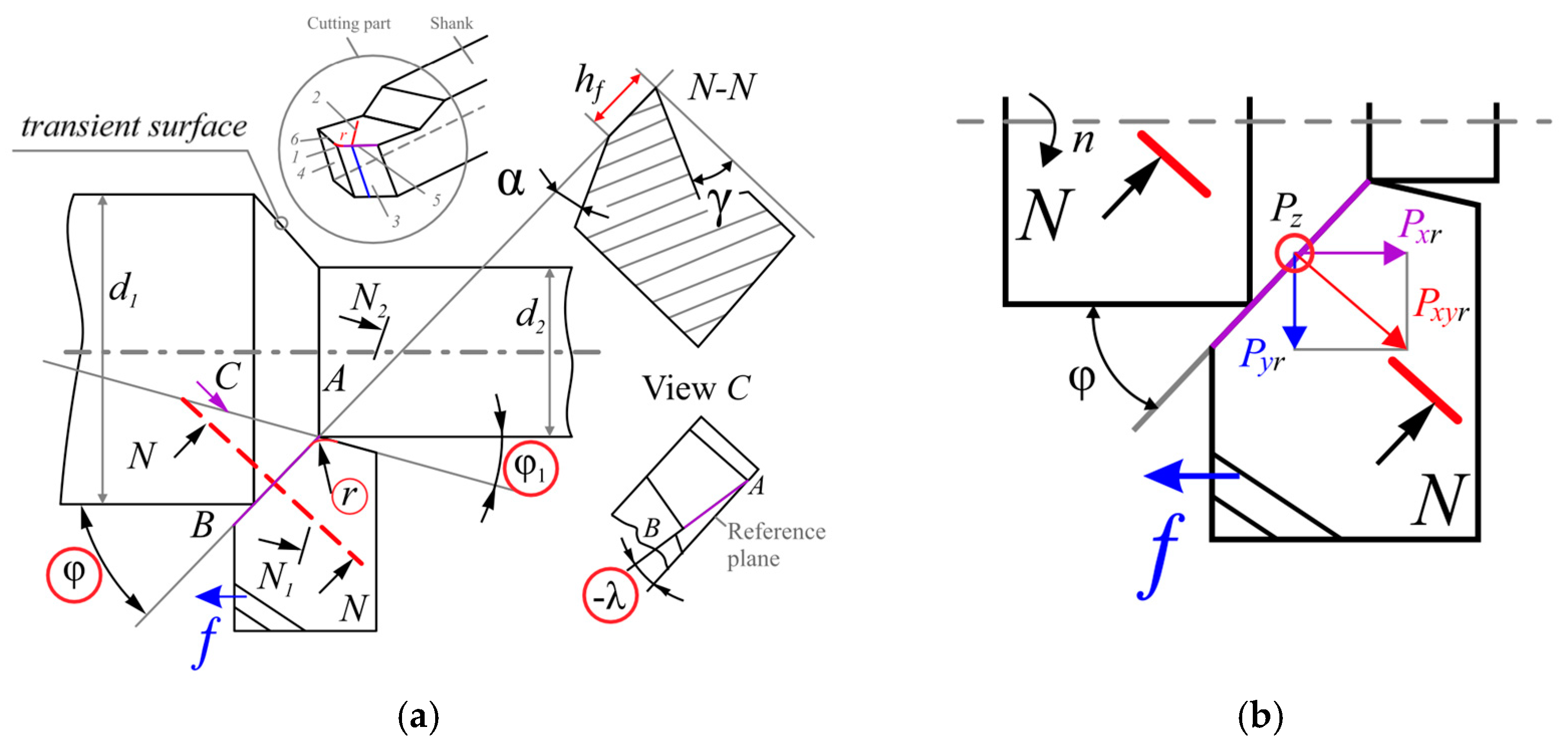

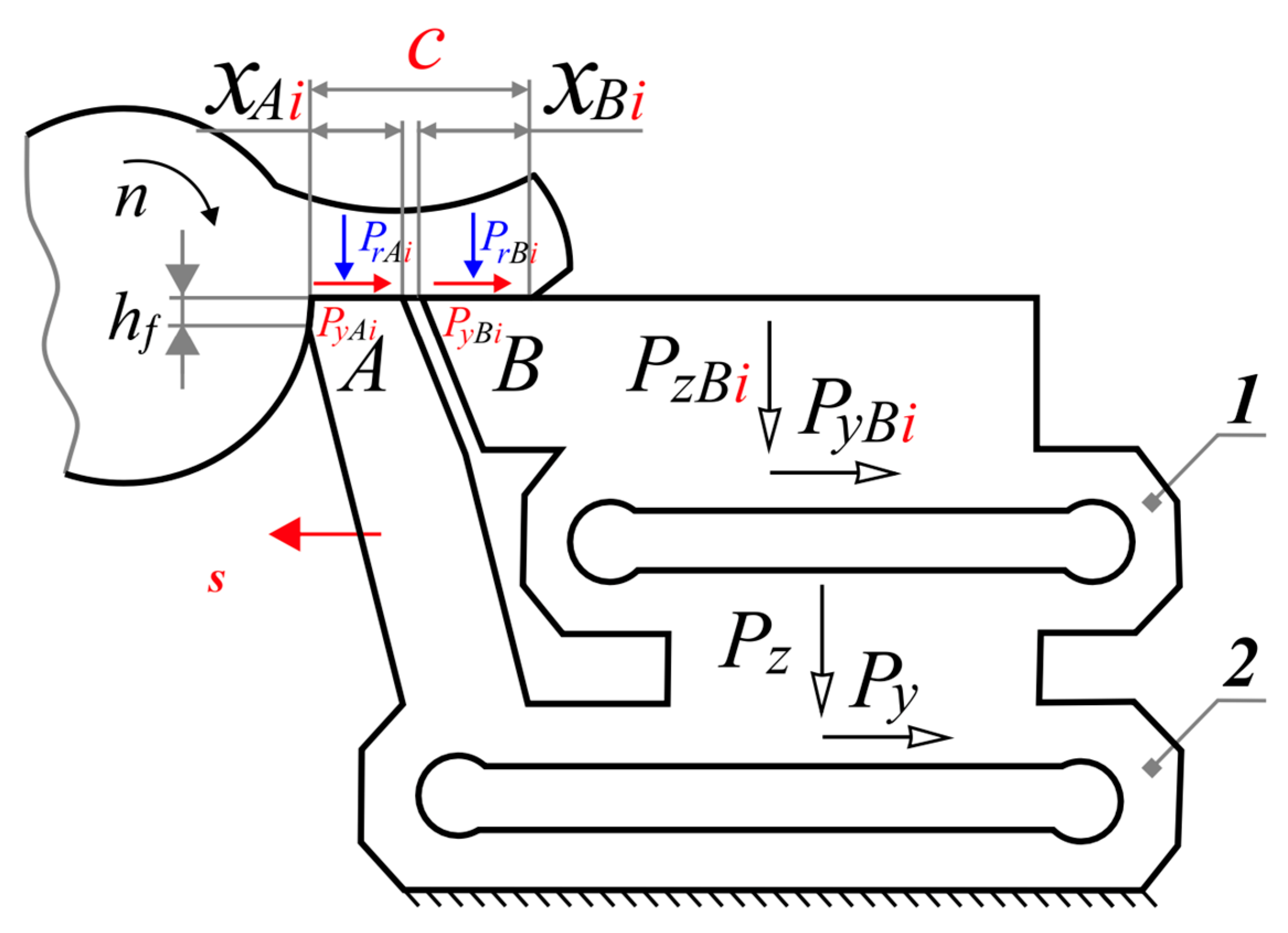


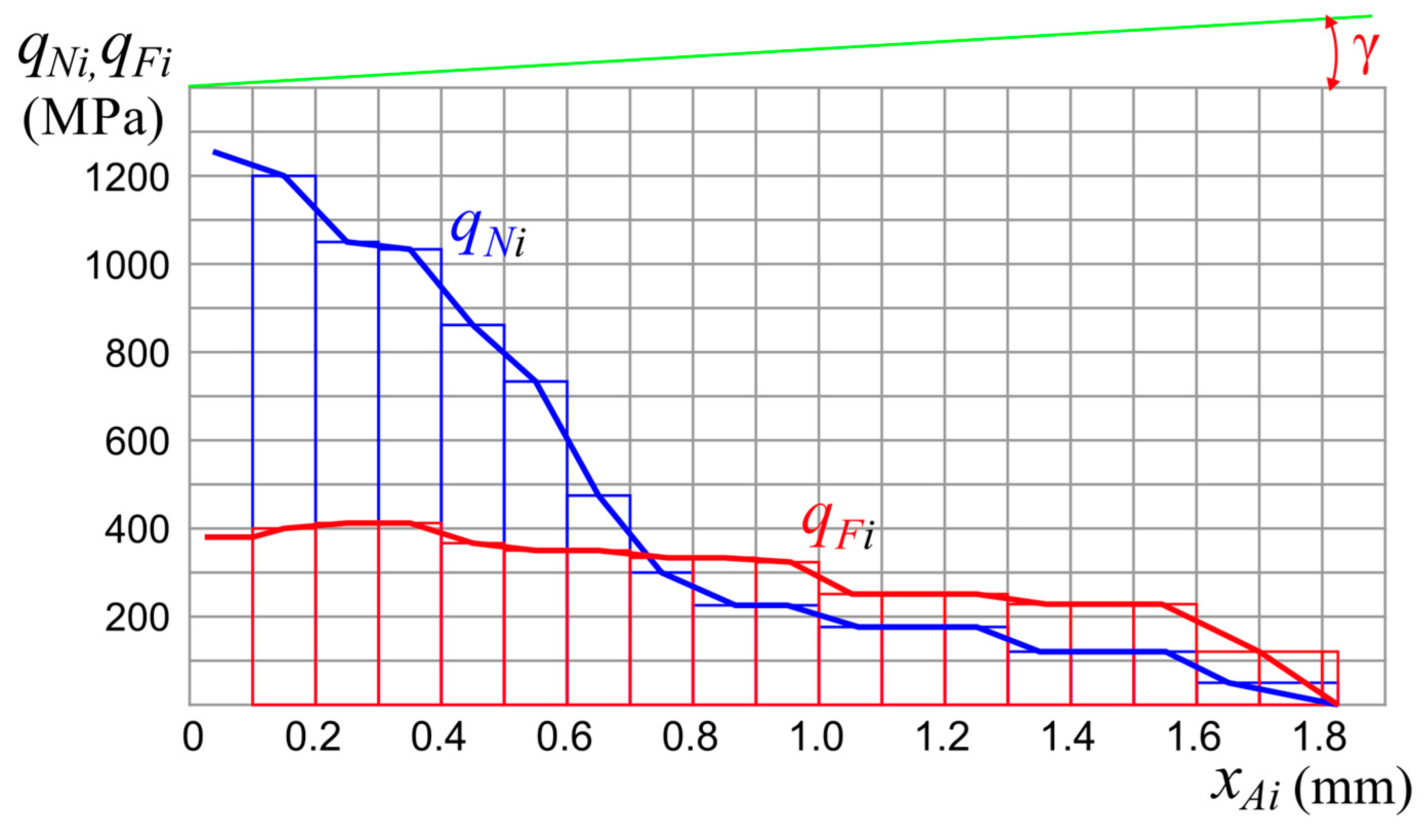
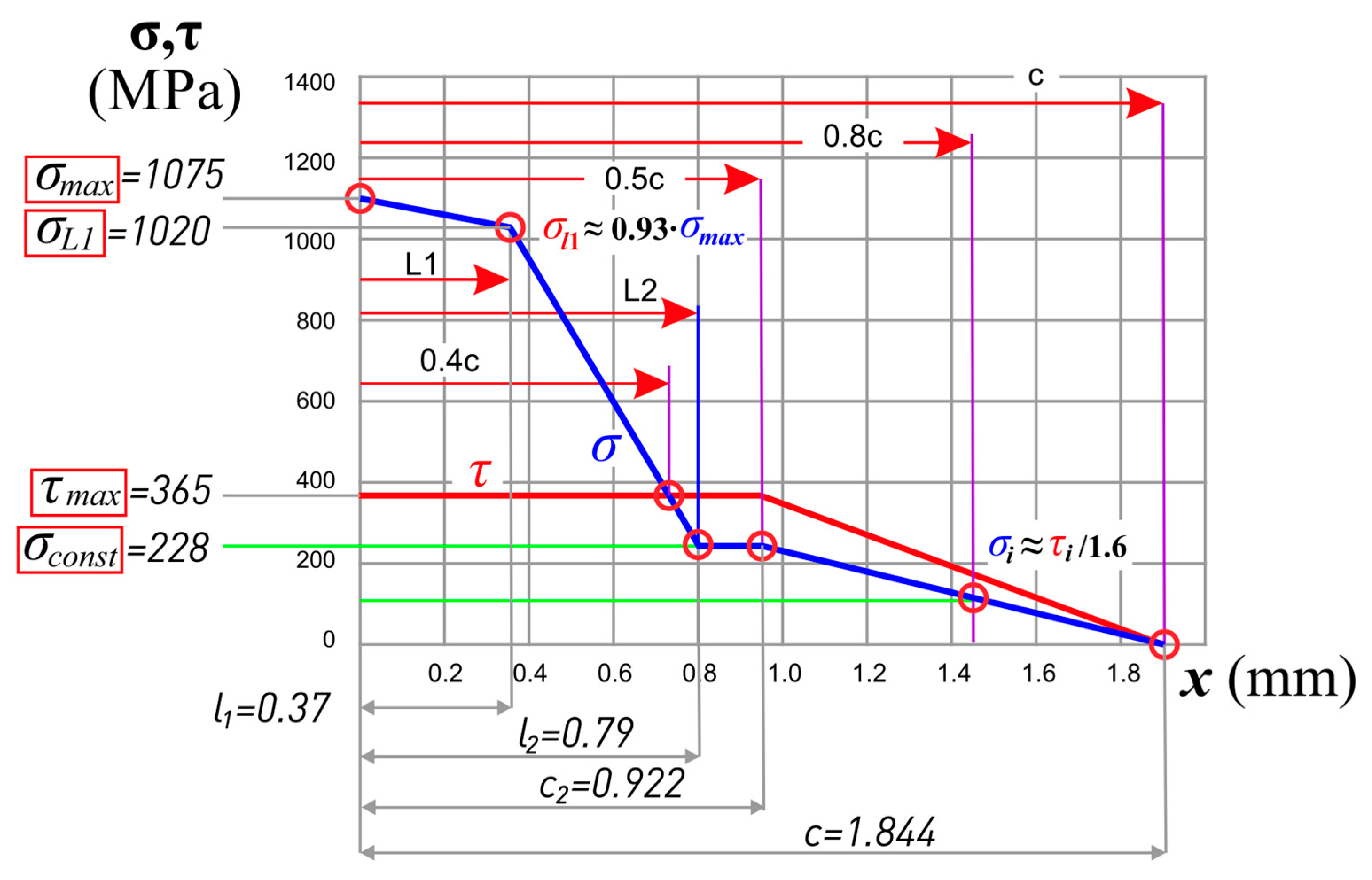

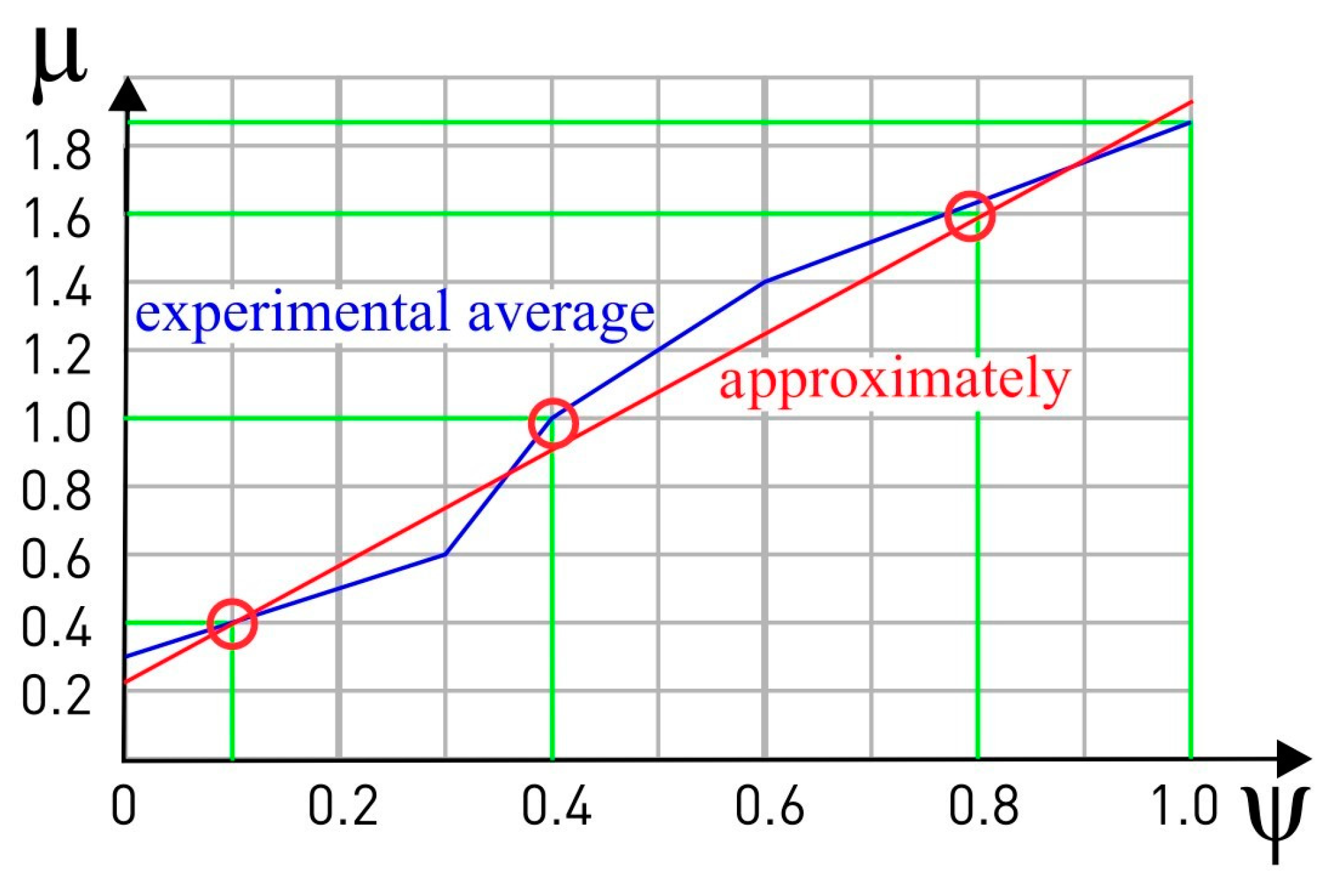
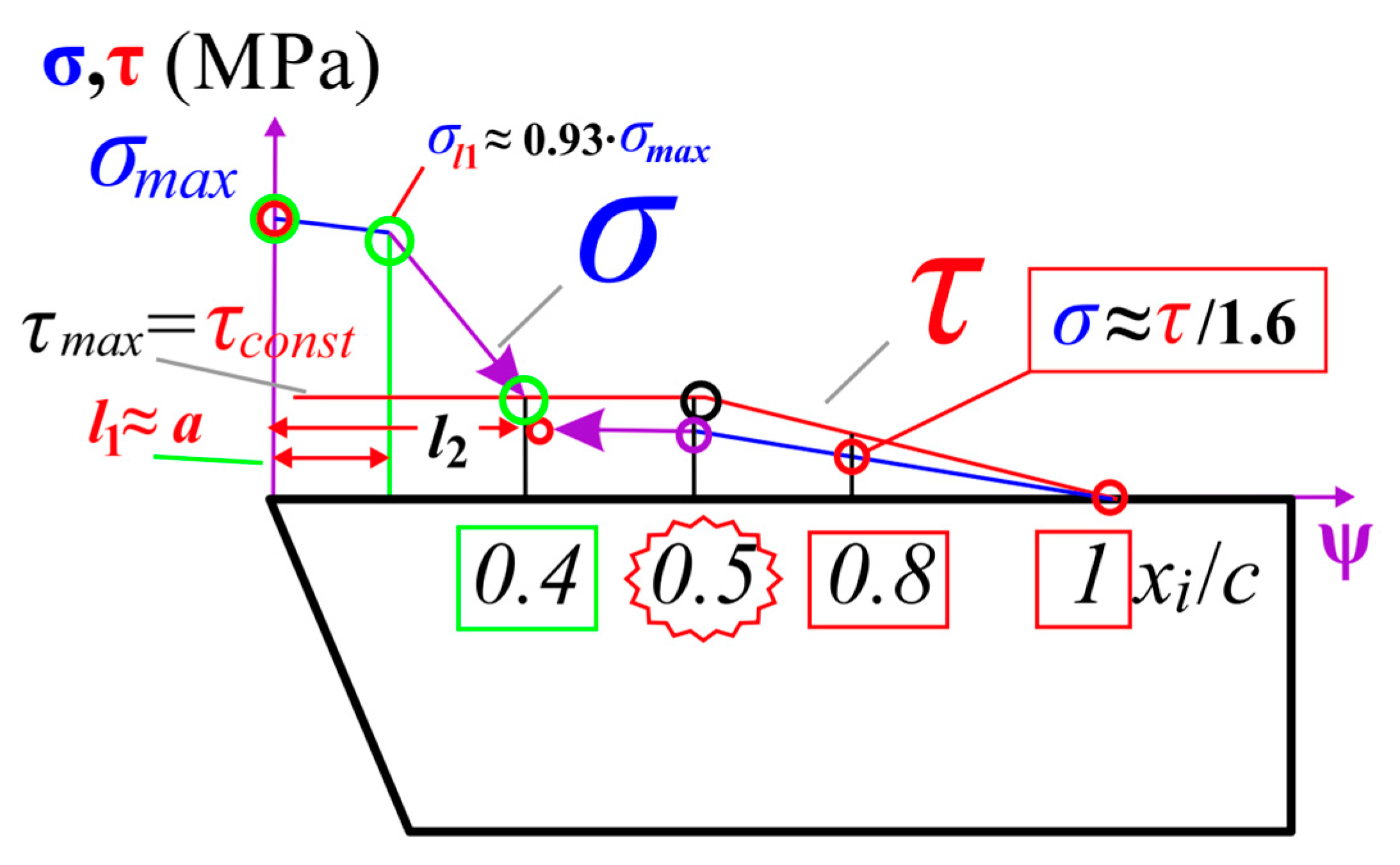
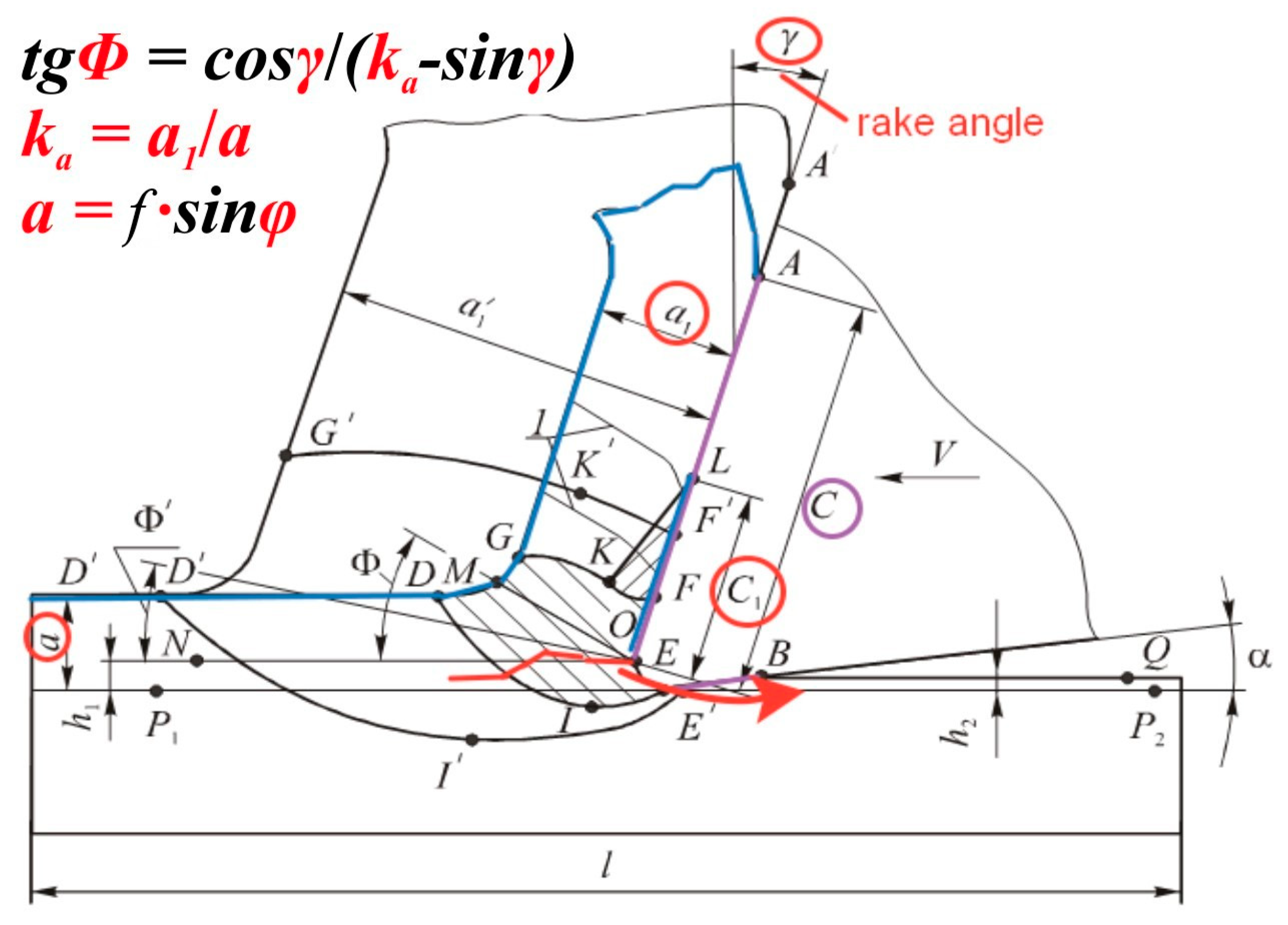
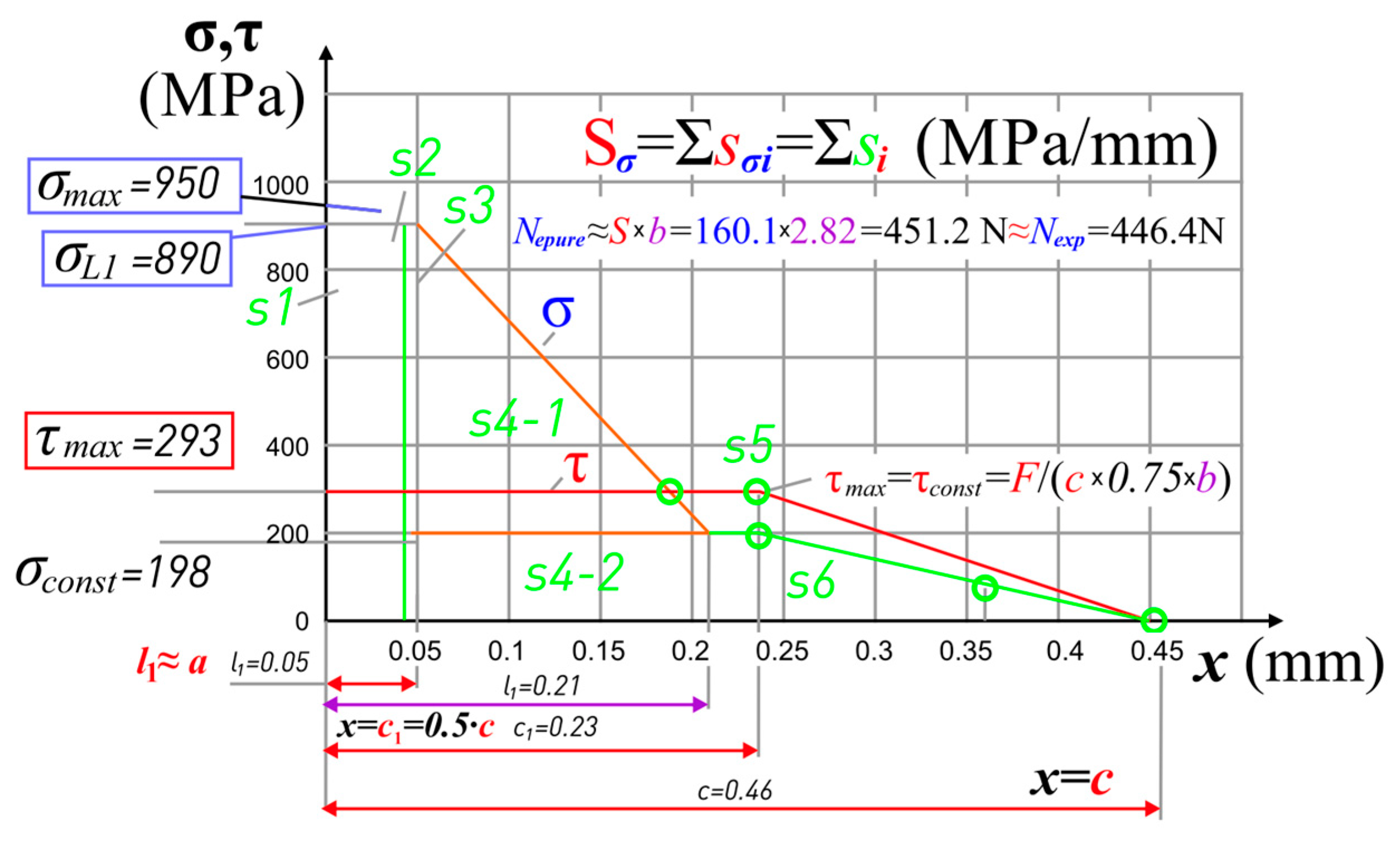



Disclaimer/Publisher’s Note: The statements, opinions and data contained in all publications are solely those of the individual author(s) and contributor(s) and not of MDPI and/or the editor(s). MDPI and/or the editor(s) disclaim responsibility for any injury to people or property resulting from any ideas, methods, instructions or products referred to in the content. |
© 2023 by the authors. Licensee MDPI, Basel, Switzerland. This article is an open access article distributed under the terms and conditions of the Creative Commons Attribution (CC BY) license (https://creativecommons.org/licenses/by/4.0/).
Share and Cite
Kozlov, V.; Babaev, A.; Schulz, N.; Semenov, A.; Shevchuk, A. Study of a Methodology for Calculating Contact Stresses during Blade Processing of Structural Steel. Metals 2023, 13, 2009. https://doi.org/10.3390/met13122009
Kozlov V, Babaev A, Schulz N, Semenov A, Shevchuk A. Study of a Methodology for Calculating Contact Stresses during Blade Processing of Structural Steel. Metals. 2023; 13(12):2009. https://doi.org/10.3390/met13122009
Chicago/Turabian StyleKozlov, Victor, Artem Babaev, Nikita Schulz, Artem Semenov, and Anton Shevchuk. 2023. "Study of a Methodology for Calculating Contact Stresses during Blade Processing of Structural Steel" Metals 13, no. 12: 2009. https://doi.org/10.3390/met13122009
APA StyleKozlov, V., Babaev, A., Schulz, N., Semenov, A., & Shevchuk, A. (2023). Study of a Methodology for Calculating Contact Stresses during Blade Processing of Structural Steel. Metals, 13(12), 2009. https://doi.org/10.3390/met13122009





